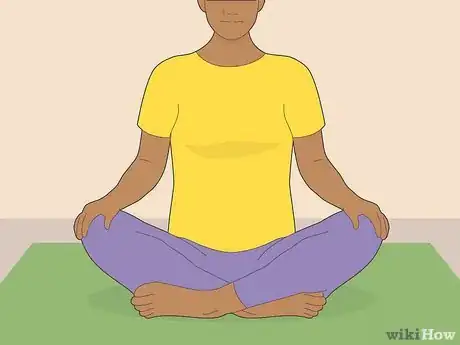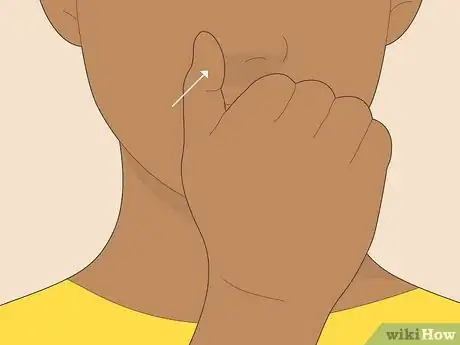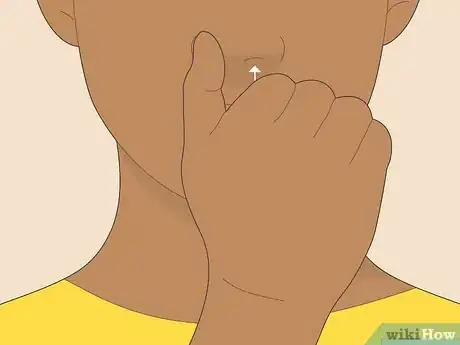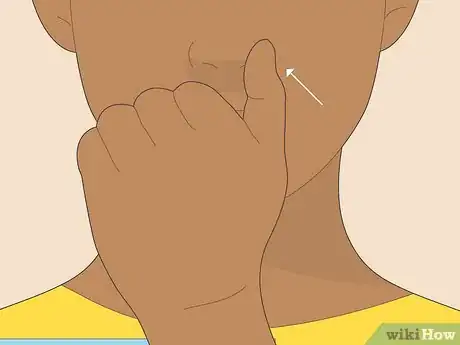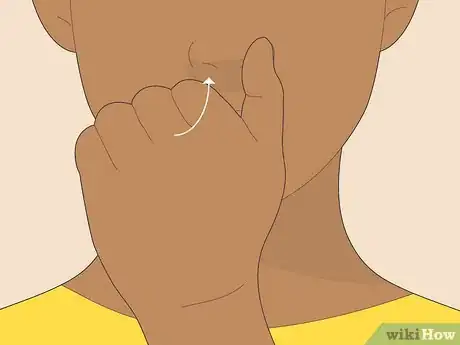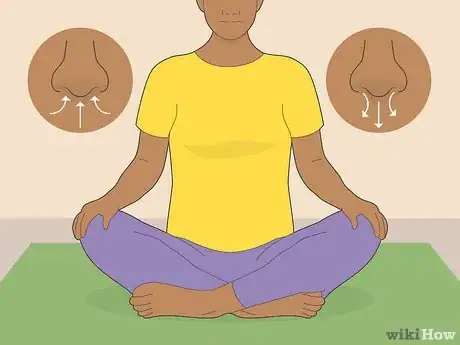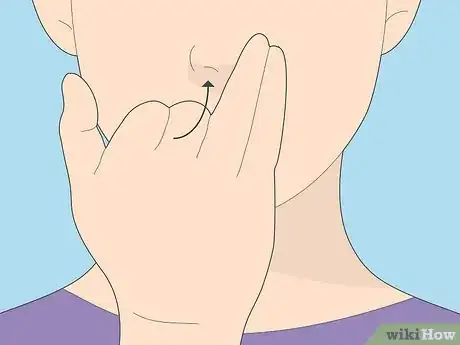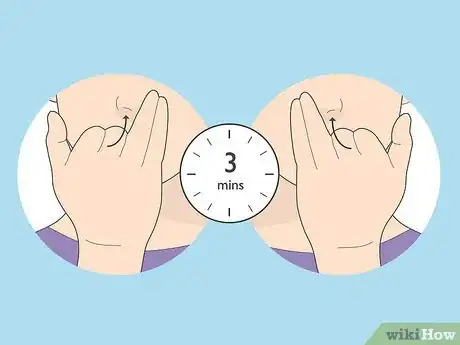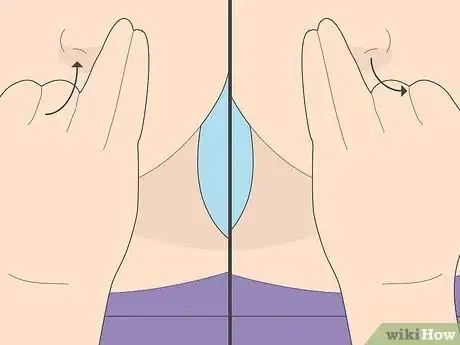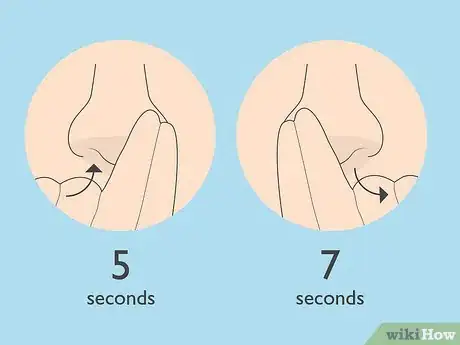This article was co-authored by Zora Degrandpre, ND. Dr. Zora Degrandpre is a Natural Health Doctor and Licensed Naturopathic Physician in Vancouver, Washington. She is a grant reviewer for the National Institutes of Health and the National Center for Complementary and Alternative Medicine. She received her ND from the National College of Natural Medicine in 2007.
There are 12 references cited in this article, which can be found at the bottom of the page.
This article has been viewed 38,885 times.
Alternate nostril breathing ("nadi shodhana," or “channel cleaning,” in Sanskrit) is a type of breathing that practitioners of yoga and alternative medicine believe harmonizes the two halves of the mind, leading to improved mental performance, health, and emotional stability. While there is no scientific evidence to confirm the mental and emotional effects of alternate nostril breathing, it has been shown to enhance the strength of the lungs, reduce blood pressure, and improve fine-motor coordination.[1] Alternate nostril breathing is easy. Simply close one nostril, breathe in deeply, then exhale. Do the same on the opposite side, then repeat as often as you like.
Steps
Learning to Breathe
-
1Sit cross-legged in an upright position. You should sit in a clean room, preferably on a mat or carpeted surface. Rest your hands lightly on your thighs. Try to get comfortable. Close your eyes. Keep your spine straight and concentrate on your normal breath for about three to five minutes.[2]
-
2Close your right nostril. Bring your right hand to your face.[3] Using your right thumb, press gently but firmly on your right nostril to prevent air from flowing into or out of it.
- Some practitioners like to bring their middle and index fingers up to rest on their foreheads or on a point between their eyes. Others simply keep their other four fingers curled into the palm.
- Keep your left hand on your thigh.
Advertisement -
3Breathe in deeply through your left nostril.[4] With your right nostril covered, take a long, slow breath in through your nose. When you’ve reached maximum lung capacity, hold your breath for a length of time equal to the time it took you to breathe in.
- Release your breath in a slow exhalation that is also equal to the amount of time it took you to breathe in.
- Once you’ve fully exhaled, uncover your right nostril and return your right hand to your thigh.
-
4Close your left nostril.[5] Bring your left hand to your face. Use your left thumb to close your left nostril by pressing it gently but firmly into the side of your nose. The process should replicate the way you closed your right nostril, but on the opposite side.
-
5Breathe in deeply through your right nostril.[6] Just as you did when you had your right nostril closed, breathe in deeply through your single open nostril. At the top of your inhalation, hold your breath for as long as it took you to inhale. Then, breathe out in a smooth motion. Remove your left thumb from your nose.
-
6Alternate your breathing through each nostril. Perform 5-10 inhalations and exhalations through each nostril, alternating each time. In other words, between your left and right nostrils, you should perform a total of 10-20 inhalations and exhalations.
- As an alternative, instead of switching nostrils after each individual inhale/exhale cycle, you could try to breathe in and out through your right nostril 10 times in a row, then breathe in and out through your left nostril 10 times in a row.[7]
Ending the Exercise
-
1Return to breathing naturally.[8] After completing your final inhale/exhale sequence, sit quietly and return to normal breathing for about five minutes. When you’re ready, open your eyes, relax your arms, and rise.
-
2Try a simple walking meditation. Alternate nostril breathing is often performed before meditation.[9] Walking meditation involves finding a quiet outdoor space in a park or backyard, and walking through it at a slow or medium pace. Stay aware of the many sensations in your feet: your feet touching the ground, the movement of your legs, and the fit of your socks and shoes.
- If you have trouble engaging in meditation at first, be patient with yourself and keep at it. The more you practice meditation, the better your technique will be, and you’ll be able to find more ways to focus on staying mindful and calm.
-
3Practice gratitude.[10] In addition to -- or instead of -- the walking meditation, try another quick meditation by practicing gratitude. Close your eyes and picture someone that you’re grateful for. Think of one aspect of their face that you really like -- their eyes, nose, or mouth, for instance. Send them a mental thank-you note by simply thinking, “I am thankful you’re in my life.” Repeat for five or six friends and family members.
Trying Variations
-
1Incorporate a mudra into you breathing. A mudra is a symbolic hand gesture used in yoga, as well as Hindu and Buddhist ceremonies, that many practitioners of yoga believe can channel energy in particular ways. It is not uncommon for someone performing alternate nostril breathing to employ the Mrigi mudra in their exercise.[11]
- Bring your index and middle finger down to touch your palm. Keep your other fingers straight and stiff.
- Instead of closing your nostrils with your thumbs, use the pinkie and ring fingers of the opposite hand.
- For instance, you could close your left nostril by forming a Mrigi mudra with your right hand, then bringing the ring and pinkie fingers of that hand to your left nostril and gently push it closed.
-
2Breathe in for a given length of time. Instead of counting the individual inhalations and exhalations during your alternate nostril breathing session, you could simply set a watch or clock for a certain time during the breathing. For instance, you might set a watch for three minutes, then close your right nostril and breathe in long and deep, hold your breath, then breathe out. After three minutes, reset the alarm and do the same on the left nostril. This will relieve you of the need to count each inhale/exhale cycle.[12]
-
3Inhale through the opposite nostril that you exhale from. In this variation, breathe in through your right nostril after first covering your left nostril with your thumb. When you’re ready to exhale, bring your left index finger across your nose and squeeze it gently against your right nostril. In the same motion, remove your left thumb from against your left nostril. Exhale through your left nostril. Repeat for as many cycles as you wish.
- Alternately, you could start by covering your right nostril first. It makes no difference.
- If you wish, you could bring your opposite thumb up to close each nostril, instead of moving your index finger across your nose to close your opposite nostril.
-
4Alternate your breathing patterns. When you’re starting out, the length of your inhalation, pause, and exhalation should be equal in length. For instance, you might breathe in slowly for five seconds, hold the breath for five seconds, then breathe out for five seconds before switching nostrils. You could, however, try to adjust these ratios to suit your own style and needs.[13]
- If you wish to relax more deeply, increase the amount of time you spend exhaling. For instance, if you breathe in for five seconds, breathe out for about seven seconds.
- If you find that you feel tired after practicing alternate nostril breathing, try adjusting your rate of inhalation so that it lasts longer than your exhalation. For instance, if you breathe in for five seconds, breathe out over a period of about three seconds. This will boost alertness and help you perk up.
Warnings
- Stop the exercise if you feel faint or light-headed.⧼thumbs_response⧽
- Use caution if you have a respiratory condition such as asthma, or if you are ill.⧼thumbs_response⧽
- If you have high blood pressure, do not hold your breath at the top of the inhalation.⧼thumbs_response⧽
References
- ↑ http://www.mindbodygreen.com/0-12936/3-reasons-everyone-should-try-alternate-nostril-breathing.html
- ↑ http://www.yogaindailylife.org/system/en/pranayamas/nadi-shodhana-pranayama-level-2
- ↑ http://www.yogaindailylife.org/system/en/pranayamas/nadi-shodhana-pranayama-level-2
- ↑ http://www.yogaindailylife.org/system/en/pranayamas/nadi-shodhana-pranayama-level-2
- ↑ http://www.yogaindailylife.org/system/en/pranayamas/nadi-shodhana-pranayama-level-2
- ↑ http://www.yogaindailylife.org/system/en/pranayamas/nadi-shodhana-pranayama-level-2
- ↑ http://www.yogaindailylife.org/system/en/pranayamas/nadi-shodhana-pranayama-level-2
- ↑ http://www.mindbodygreen.com/0-12936/3-reasons-everyone-should-try-alternate-nostril-breathing.html
- ↑ http://www.artofliving.org/us-en/yoga/breathing-techniques/alternate-nostril-breathing-nadi-shodhan
- ↑ http://health.usnews.com/health-news/health-wellness/articles/2013/07/30/3-meditation-techniques-for-beginners
- ↑ https://www.grdhealth.com/articles/left-nostril-breathing-calming
- ↑ https://chopra.com/articles/nadi-shodhana-how-to-practice-alternate-nostril-breathing
- ↑ https://www.3ho.org/files/pdfs/alternate-nostril-breathing.pdf
